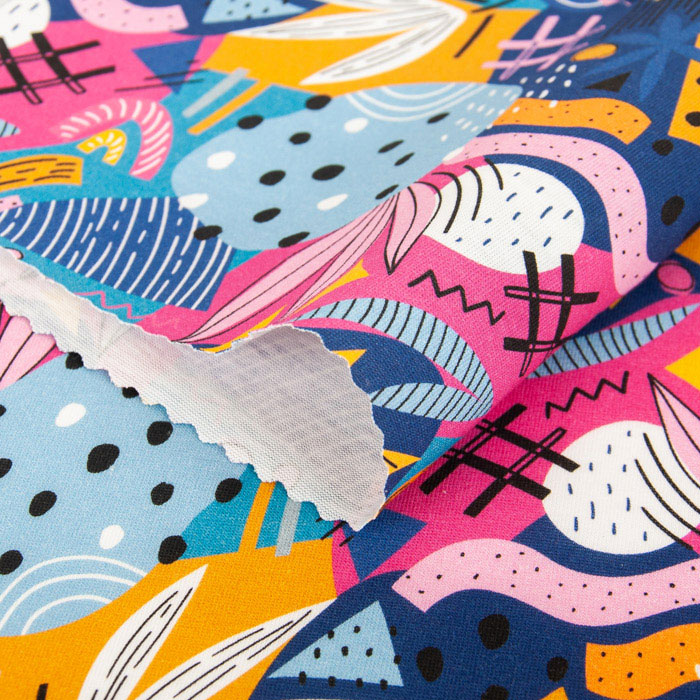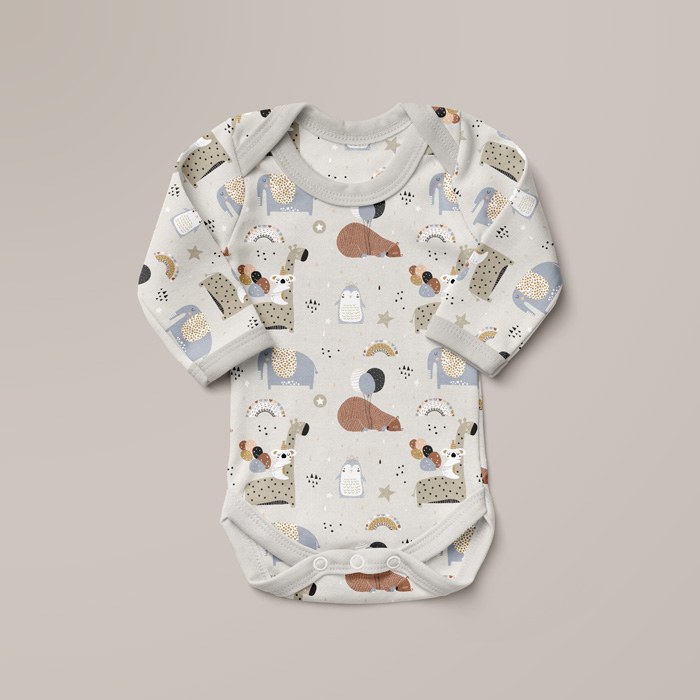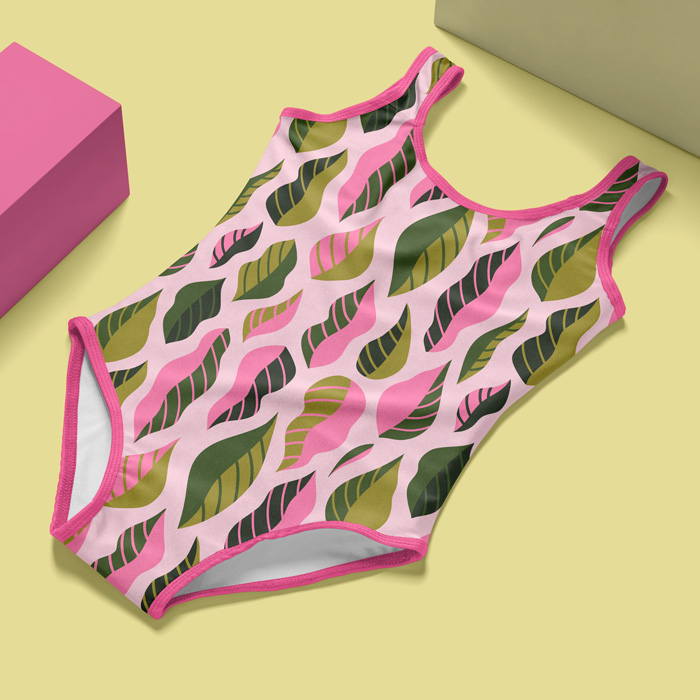Sewing with jersey is not only a challenge but also an opportunity to create unique and functional projects. In this article, we’ve discussed key steps and tips that will help you achieve excellent results when working with this elastic fabric. From choosing the fabric to selecting the right stitch and creatively using scraps – discover all the secrets of sewing jersey that will make your projects unique and durable.
Table of Contents
- What kind of fabric is jersey? The benefits of knitwear
- What can you sew from jersey?
- Sewing jersey – what do you need?
- Sewing jersey – which stitch to choose?
- Key tips for sewing jersey
- Washing jersey before sewing – yes or no?
- Sewing jersey scraps – what can you do with them?
- Summary
What kind of fabric is jersey? The benefits of knitwear
Jersey, often also referred to as knit fabric, is a type of knitted fabric with exceptional properties that make it highly desirable in tailoring. Its main characteristics are elasticity, softness, and breathability. Because it is a stretchy material, it perfectly conforms to the body shape, making it comfortable to wear and providing full freedom of movement.
One of the greatest advantages of jersey is its versatility. It can be used to sew a variety of garments, ranging from everyday wardrobe staples such as T-shirts and sweatshirts to sports and recreational clothing like leggings or swimsuits. For fashion designers, it’s a material that offers a wide range of design possibilities and allows for the creation of original and functional creations.
Additionally, jersey is also known for being relatively resistant to damage, making it a durable material. It doesn’t require frequent ironing as it rarely wrinkles, which is an added bonus for those who value comfort and practicality.

What can you sew from jersey?
Jersey is perfect for sewing everyday clothing such as T-shirts, sweatshirts, skirts, or leggings. Thanks to its softness and elasticity, they provide comfort and freedom of movement. Additionally, jersey works great in the production of sportswear and activewear because it effectively wicks moisture away and ensures a good fit to the body.
For children, jersey is a material that offers exceptional comfort and safety. With its help, you can sew various garments, from rompers and bodysuits for infants, through colorful shorts and dresses for children’s wardrobe, to comfortable tracksuits and sweatshirts. Additionally, jersey works great as a material for producing accessories for children, such as bibs, blankets, or caps, because it is gentle on the skin and easy to clean.
In addition to clothing, you can also sew various accessories and items from jersey, such as scarves, headbands or gloves Its elasticity and softness make them not only stylish but also comfortable to use.
Finally, jersey is also excellent as a fabric for bedding production. Jersey bedding is soft to the touch, soft, and durable, guaranteeing a peaceful sleep and full comfort of use.

Sewing jersey – what do you need?
To effectively work with jersey, it’s worth having several essential sewing tools and accessories on hand. Here’s a list of things that will come in handy when sewing with this soft and elastic fabric:
- Special machine needle: Standard needles may be too sharp or wide for sewing jersey, which can lead to fabric damage. Therefore, it’s worth investing in needles specifically designed for knits, which have rounded tips and are more flexible, minimizing the risk of thread breakage and fabric damage.
- Sewing tape or interfacing G785: Jersey has a tendency to curl during sewing, which can cause problems in maintaining straight edges. Using sewing tape or interfacing G785 as support for seams helps control this problematic fabric feature, ensuring seam evenness and stability.
- Overlock machine: Although an overlock machine is not essential, it’s very useful when sewing jersey. It allows for simultaneous cutting and finishing of fabric edges, giving a professional effect and increasing the seam’s durability. However, sewing jersey without an overlock is also possible by using the appropriate stitch, such as a zigzag stitch.
- Ironing and steaming: Before starting sewing, it’s worth ironing the jersey fabric to remove wrinkles and facilitate work. Steaming the fabric can also help soften its fibers and ensure better fitting during sewing.
- Proper threads: Choosing the right threads is crucial for seam durability. High-quality threads should be used, which are elastic and resistant to stretching. Polyester or blended threads are usually recommended for sewing jersey because they provide durable and elastic seams.
- Fabric glue (optional): Gluing small details before sewing can facilitate work, especially on difficult edges or with thin and elastic materials like jersey. Fabric glue, which is easy to remove after sewing, can help stabilize the seam and avoid material shifts.
Sewing jersey – which stitch to choose?
Choosing the right stitch when sewing with jersey is crucial for the final effect and seam durability. Jersey, due to its elasticity and softness, tends to curl and stretch during sewing, so it’s important to use the appropriate stitch that will ensure seam stability and avoid fabric distortion.
The most commonly recommended stitch for sewing jersey is the zigzag stitch. It’s an elastic stitch that perfectly adapts to the fabric’s movements, preventing it from stretching and curling.
If an overlock machine is available, it’s also worth considering using it for sewing jersey. An overlock machine allows for simultaneous cutting and finishing of fabric edges, giving a professional effect and increasing seam durability.
Key tips for sewing jersey
When sewing with soft and elastic materials like jersey, there are several key tips that can make the process easier and more effective. Wait 15 minutes after cutting the fabric. After cutting jersey fabric, it’s worth waiting about 15 minutes before starting sewing. This allows the fabric to stabilize and avoids distortions that may occur during material manipulation. Use sewing tape or interfacing G785. To prevent jersey from curling during sewing, it’s recommended to use sewing tape or interfacing G785. These tapes can be placed on the fabric’s edges before sewing, which helps keep the fabric in place and prevents it from shifting.
Washing jersey before sewing – yes or no?
Washing jersey before starting sewing can be beneficial for several reasons. However, the decision whether to wash this fabric before starting work depends on several factors, including individual preferences and the specifics of the project.
One of the main arguments for washing jersey before sewing is the process of preshrinking. Preshrinking involves subjecting the fabric to water and temperature, which stabilizes its dimensions. Thanks to this process, we avoid potential shrinkage or deformation of the fabric after the first washing of the finished product. This is particularly important for projects that may be subject to regular washing, such as clothing or bedding.
Additionally, washing jersey before sewing can help remove any dirt, chemicals or contaminants that may be present on the fabric after the production process. This, in turn, can prevent stains or discoloration on the finished product.
However, there are also arguments against washing jersey before sewing. Some argue that washing can soften the fabric and reduce its stability, which can be problematic during precise sewing.
Read more: How pattern size can influence an outfit?
Sewing jersey scraps – what can you do with them?
From jersey scraps, you can create not only practical but also creative and original items. Here are a few ideas for using leftovers from jersey sewing projects:
- Underwear: Leftovers from larger jersey projects are perfect for making underwear. The material is soft, elastic, and comfortable for the skin, making underwear made of jersey comfortable to wear and perfectly fitting the body.
- Socks: Jersey scraps can be used to make soft and comfortable socks, especially for children. Jersey socks are gentle on the skin, fit well on the feet, and provide a comfortable feeling throughout the day.
- Headbands: Small pieces of jersey can be used to make fashionable and practical headbands.
- Scarves: Jersey scraps can be used to make lightweight and soft scarves, which are a perfect addition to spring and summer outfits.
It’s worth remembering that the possibilities of using jersey scraps are practically unlimited, and the only limitation is imagination and creativity. We encourage you to experiment and create unique items from the remaining pieces of this soft and versatile fabric.

Summary
The world of sewing with jersey is wide open to you, full of countless possibilities and inspirations. Let every project you create be an expression of your passion and creativity. Remember that sewing is not only a craft but also a way of expressing yourself and creating unique works of art. So discover your talents, experiment with different techniques, and enjoy every stitch. Because, in the end, sewing with jersey is not just work, it’s also pleasure and satisfaction from creating something beautiful with your own hands. Choose your dream pattern, print it on jersey, and create your original projects with CottonBee!





